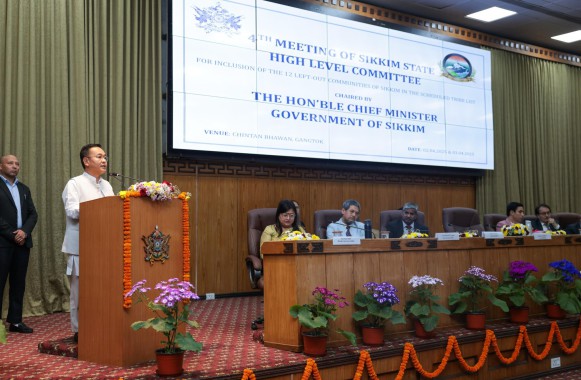




















Friday, Apr 04, 2025 19:45 [IST]
Last Update: Friday, Apr 04, 2025 02:45 [IST]
GANGTOK, (IPR): The 4th and final meeting of Sikkim State High Level Committee (SSHLC)
for inclusion of the 12 left-out communities of Sikkim in the Scheduled Tribe
list was held at Chintan Bhawan here on Thursday.
The
meeting was chaired by Chief Minister Prem Singh Tamang-Golay which was
attended by minister Arun Kumar Upreti, MLA-SSHLC member BS Panth, SSHLC chairman
Professor BV Sharma, vice chairman Professor Mahendra P Lama, member secretary,
SSHLC &secretary Social Welfare department, Sarika Pradhan, andEIECOS+1
chairman Dr Shiva Rai.
Chief
Minister Prem Singh Tamang-Golay, in his address, stated that the SSHLC was
constituted by the State government to determine the modalities for including
the 12 excluded communities of Sikkim in the Scheduled Tribes list under the
Constitution of India. He expressed gratitude for participating in the fourth
and final meeting of the Sikkim State High Level Committee.
The
Chief Minister noted that the SSHLC presented its final report and stated that
the process that began in mid-December 2024 is now complete. This initiative
brought together community members, experts, professionals, government
officials, and political leaders to discuss a matter of public interest.
He
highlighted the broader perspectives, including Sikkim's political history, law
and governance, agreements, merger with India, and national security
considerations. He stated that the proposals on peace dividends, the
interpretation of the inclusive Sikkimese term, and comparisons with
constitutional and governance frameworks in other north-eastern States have strengthened the case for inclusion.
The
Chief Minister stated that the report contains ethnographic data on the 12
communities, compiled with detailed research and analysis.He suggested that the
SSHLC provide a list of recommendations to facilitate engagement with various
government agencies. He also encouraged community organisations and
representatives to discuss the ethnographic findings with youths and social
workers to prepare for further social and intellectual initiatives.
SSHLC
chairman Professor BV Sharma expressed his gratitude to the Government of
Sikkim, the Chief Minister, and all other members in his address. He thanked
them for giving him the opportunity to interact with others, gain knowledge,
and contribute to the inclusion of 12 left-out communities.
Sharma
expressed his satisfaction with the feedback provided by the representatives of
each community. He also conveyed his appreciation for being given the chance to
serve the 12 left-out communities.He acknowledged that everyone involved has
worked hard and taken the assignment seriously. He stated that each word in the
report was chosen carefully, and many references were used to ensure accuracy
and clarity.
Sharma
explained how the report was drafted and stated that the researchers from the
communities had played a vital role in its preparation.
SSHLC
vice chairman Professor Mahendra P Lama, in his address, laid out the final
report of SSHLC, wherein he mentioned why ‘Scheduled Tribe’ status is important
and needed.He talked on the following topics:
1.Sikkim's
Unique History, Mountainous Borderlands, and 50 Years of Merger with the Indian
Union: Going Beyond the Five Criteria.
2.
Executive Summary of Ethnographic Reports of 12 Left-out Communities.
3.
Going Beyond the Five Criteria for the Inclusion of 12 Left-out Indigenous
Sikkimese Ethnic Communities in the Scheduled Tribe List in the Constitution of
India.
4.
Pre- and Post-Merger Sikkim.
5.
Heart of Peace, Tranquility, and Stability in Sikkim: Four Roles of Sikkimese
Communities.
6.
Reflections on Peace and Stability Effects.
7.
The Government of India Act, 1935: Excluded Area Provisions.
8.
Redeeming the Missed Opportunity.
9.
Income Tax Exemptions: Brought at Par with the Tribals of the NE States.
10.
Report of the Sikkim State High-Level Committee Adopted the Following Five
Critical Pathways and Methodologies.
EIECOS+1
chairman Dr Shiva Rai in his address outlined the work completed in previous
SSHLC meetings. He stated that reading ethnography reports provided useful
insights and learning opportunities. He acknowledged the efforts of each
community in producing the ethnography report on 12 left-out communities. He
stated that the report is structured with consideration of the historical
context of these communities.
Dr
Rai also discussed Article 371F(g) of the Indian Constitution, which relates to
Sikkim. He urged everyone present to raise awareness of the work carried out at
the grassroots level.
Earlier,
in her welcome address, secretary Social Welfare department cum member secretary
SSHLC, Sarika Pradhan, underscored the significance of the meeting in ensuring
the inclusion of the 12 excluded communities in the Scheduled Tribe list. She
highlighted that the primary focus of the meeting is submission of the reports
prepared by SSHLC members to the Government of Sikkim. She hoped that the deliberations
would be insightful and productive for meaningful progress towards securing the
recognition of the excluded communities.
The
meeting also saw the submission of reports by members of the SSHLC to the Chief
Minister.
Thereafter,
the members of the Sikkim State High Level Committee presented the final ethnographic
report of 12 left out communities.
Thereafter,
the representatives of the 12 left-out communities put forth their feedback on
the presentation.
